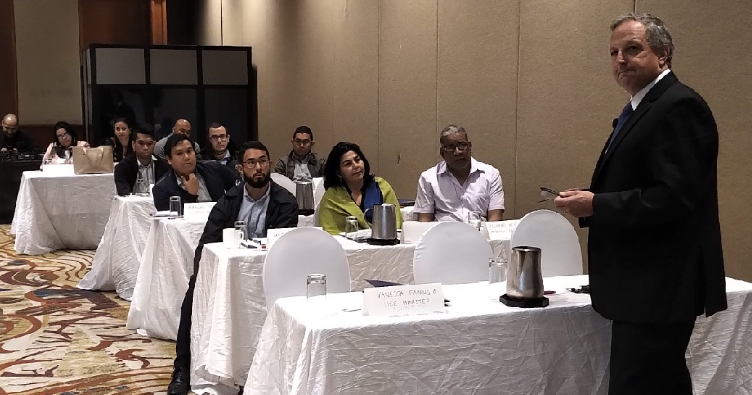
The School of Public Policy’s Extractive Resource Governance program presents a workshop in Panama.
School of Public Policy
Oct. 16, 2019

The School of Public Policy’s Extractive Resource Governance program presents a workshop in Panama.
School of Public Policy
The world’s third largest copper deposit is set to literally light up the lives of the people living near it. The Cobre Panama mine, which represents a $10-billion investment by the Canadian firm First Quantum Minerals Ltd., is bringing electricity for the first time ever to the villagers living in the area.
“The mine had to build a 300 megawatt energy plant, and of those, they’re giving back 100 MW to the local community that never had electricity before,” says Deborah Archibald, a geologist and director of the School of Public Policy’s Extractive Resource Governance program (ERGP).
Archibald led a two-day “Mining 101” workshop for government officials Sept. 26 and 27 in Panama City to teach them about such things as best practices for formulating effective policy and regulatory frameworks, community consultation and environmental impact assessments. Many of the attendees were from Panama’s Ministry of Commerce and Industry.
“They have no stand-alone mining department. The industry has been so small; they’re trying to decide if they should set up a department,” Archibald says. She was pleased to see how enthusiastic the delegates were about learning everything they can around best practices, especially in community consultation.
“It was invigorating because it was a really young group of people. They were so knowledgeable and enthusiastic, so keen. They see the opportunity to improve the lives of their people; many live in poverty and are not well educated. It’s about quality of life through mineral development,” she says.
Production began in July when the Cobre mine shipped its first two loads of copper concentrate. Until now, Panama’s economy has relied mainly on ships transitioning the Panama Canal. From now on, the canal will also serve the mine — located in Colon province, just 20 kilometres from the Caribbean seacoast — as it ships copper all over the world.
“Panama has not had a hardrock mining industry to speak of,” Archibald says. “Their current mining law dates back to the 1960s and they want to modernize that law.”
Electricity is not the only gift the mine has given the villagers. Unable to give jobs to everyone, the mine came up with other ingenious ways to give back to the community, such as funding the establishment of farms to raise chickens which are then killed and sold to the mine. And Archibald says that for every area the mine had to clear, it has developed an equal amount of land.
“They’ve assisted the communities in establishing agricultural land. The people in the immediate area are quite enthusiastic about the mine because of the direct benefits to them,” she says. The land is being used to grow coffee, which is exported out of the country. The mine has also made donations to the local hospitals.
When the ERGP visits a country like Panama to offer its expertise in resource extraction issues, it’s the start of a longer-term relationship.
“We had discussions about facilitating a study tour for them to come to Canada,” Archibald says. “That might be the next step.” Such a study tour would involve meetings with environmental assessment agencies and possibly with Indigenous people affected by mining.
“Our workshop touched on a little bit of everything about governance. If they want a deeper dive, they could do it by webinar. They’re interested in more advanced training in community consultations,” she says.
With a large financial sector in Panama City, the government is keen on developing economic opportunities in Panama’s remote regions. And when those opportunities involve resource extraction, the School of Public Policy’s Extractive Resource Governance program could well be there to lend a helping hand.